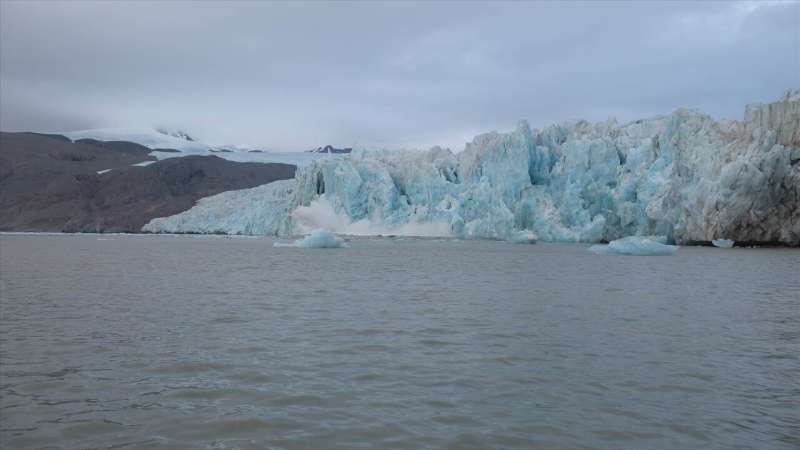New measurements shed light on the impact of water temperatures on glacier calving

Calving, or the breaking off of icebergs from glaciers, has increased at many glaciers along the west coast of Svalbard. Now, researchers at Stockholm university have shown that, whilst subsurface water temperatures are the most important driver of frontal mass loss, they are not as important as previously thought.
With the help of new temperature sensors, which are being developed in collaboration with KTH, the Royal Institute of Technology, the researchers have collected continuous time series of water temperatures from locations in close proximity to the glaciers Tunabreen and Kronebreen. The results show that subsurface water temperature exerts the greatest influence on the mass loss of the glaciers—but it is not as significant as previously thought.
"One of the greatest uncertainties surrounding future sea level rise is how glacier dynamics change when glaciers come into contact with warming waters. Our measurements and results can be used to improve numerical models which estimate future sea level rise" says Felicity Holmes, a Ph.D. student at the Department of Physical Geography, Stockholm University, and lead author of the study.
Many glaciers in the polar regions are shrinking due to global warming, contributing to sea level rise. Glaciers which extend into water don't only lose mass through melting on the surface, but also through the loss of icebergs in a process called calving.
"Calving is a process which is not completely understood, but with the measurement technology that we used in Svalbard, we have a good opportunity to increase our knowledge of which factors interact when glaciers calve. A better understanding of calving processes also benefits prognoses of how glaciers in West Antarctica will react to warming waters" says Nina Kirchner, Associate professor in glaciology at the Department of Physical Geography, Stockholm University, and director of the Bolin Centre for climate research.
When warm water from the Atlantic intrudes into fjords where glaciers meet the ocean, calving rates increase. This is seen along the west coast of Svalbard. But, the lack of data in close proximity to glacier fronts has made it hard to clearly identify warm water as the cause, due to the fact that measurements taken further away often give an incorrect picture of the water masses that actually reach the glacier fronts. This can therefore lead to an over- or under- estimation of how much the ocean actually impacts calving glaciers.
The new datasets are the first taken within just a kilometre of the glacier fronts and therefore play an important role in increasing our understanding of the impact of subsurface temperatures along Svalbard's west coast.
"It is exciting to develop measurement technology in close co-operation with climate scientists—together we work to make the technology cope with the tough challenges that the polar environment places on underwater instruments" says Jakob Kuttenkeuler, Professor at the Maritime Robotics Laboratory at the Royal Institute of Technology (KTH).
"We are proud of the unique measurements that we could collect in close proximity to the glacier fronts over the course of a whole year—the measurement series is now openly available to other researchers to use" concludes Holmes.
The study is published in Scientific Reports.
More information: Felicity A. Holmes et al. Relating ocean temperatures to frontal ablation rates at Svalbard tidewater glaciers: Insights from glacier proximal datasets, Scientific Reports (2019). DOI: 10.1038/s41598-019-45077-3
Journal information: Scientific Reports
Provided by Stockholm University





















